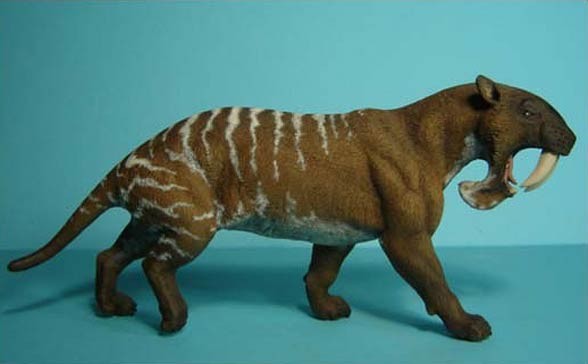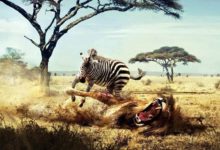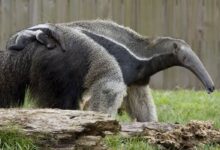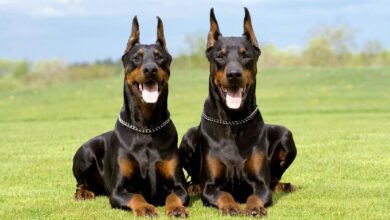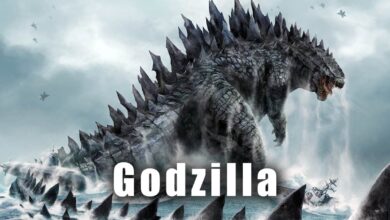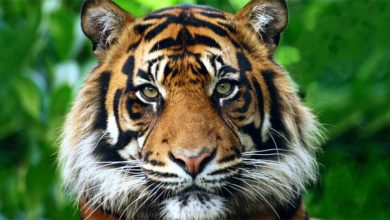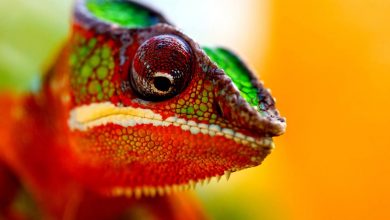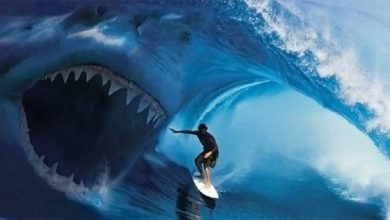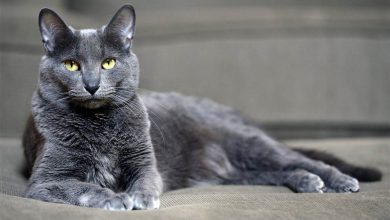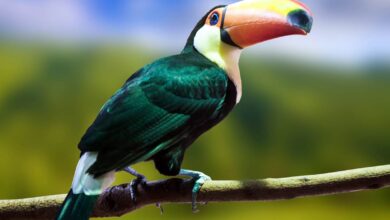Thylacosmilus – a predatory marsupial from South America
Thylacosmilus
It could be said that Thylacosmilus was South American Smilodon. The differences between this carnivorous marsupial and the saber-toothed tigers, however, were significant. With time, it turned out, among other things, that the latter is much better adapted to ecosystem changes than its rival from South America. Let’s find out more details about one of the largest carnivorous marsupials in history.
Classification
- Phylum: Chordata
- Class: Mammalia
- Infraclass: Metatheria
- Superorder: marsupials
- Order: Sparassodonta
- Family: Thylacosmilidae
- Genus: Thylacosmilus
- Species: Thylacosmilus atrox / Thylacosmilus lentis
Dating and distribution
It lived from the late Pliocene, 10 – 2 mln years ago. It existed in the areas of present South America, mainly Argentina. Most of its fossils were discovered in the province of Entre Rios, La Pampa and Catamarca.
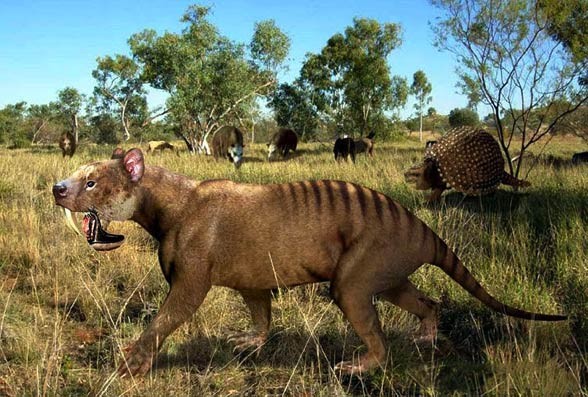
Characteristics
The appearance – similarity with smilodons?
Thylacosmilus was 1.2-1.5 m long and could weigh 80-120 kg (maximum 150 kg). Its size was similar to the present-day jaguars and leopards.
The built of the skull made it similar to saber-toothed cats, which means it was adjusted to transferring the strength of neck muscles to long upper canines, which were used to kill prey. Powerful forelimbs and the loose-jointed skeleton confirm the hypothesis, which says that the marsupial killed by immobilizing the prey and then doing precisely deep bites driven by big and powerful neck muscles.
However, there are some prime differences between the South American marsupial and the smilodon. The most important one is the fact that smilodons are placental mammals. It means that during the pregnancy, the fetus inside the mother’s body is joined with it by the placenta. Marsupials, as the name suggests, have got the pouch where infants are transported to grow there till they reach full independence.
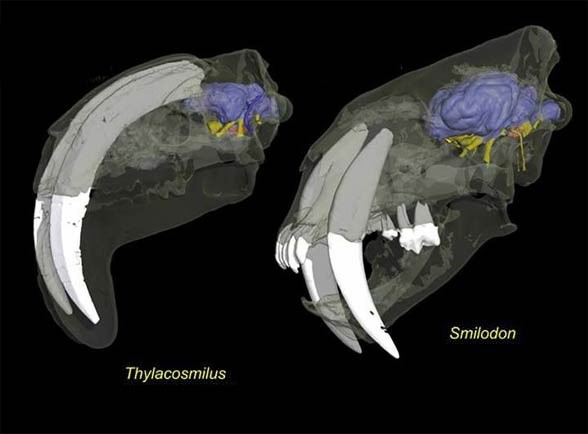
Differences
There are many differences as far as dentition is concerned. Thylacosmilus had teeth growing all its life; therefore, the animal had to scrape them regularly, for example by biting bones. Huge canines were additionally protected by special jaw involucres, which protected teeth against breakage or excessive wear when the mouth was closed.
Jaws opened at a very wide angle, which let the marsupial use long canines effectively. The consequence of this ability was the low power of the bite. However, it was not a disadvantage for the predator of Thylacosmilus sort. It could kill using only two teeth focusing its strength on sticking them like daggers and not on the power of the bite.
Apart from canines, the animal had a full set of teeth including short and blunt lower canines as well as other reduced teeth. However, it probably did not have incisors.

The hunting tactic
Its enormous canines were used similarly to smilodons. It hunted by the ambush, it lurked in the low vegetation or it jumped on the prey from above. It attacked with surprise to prevent the victim from any reaction. It caught the prey at the neck and then bit with its canines, which caused the disruption of arteries. The hunted animal died as the result of quick bleeding out.
Although Thylacosmilus is often presented as the sole hunter, it is not excluded that it hunted in groups. Mothers could hunt with their young being kept in the pouch and when they got out of the pouch, they could accompany their mothers till they became mature.
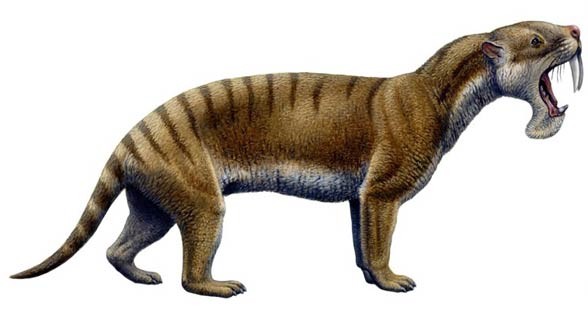
The reason for extinction
Smilodons were probably the reason for Thylacosmilus dying out. When North America (where smilodons lived) joined South America, the migration of many animal species started, among other things saber-toothed cats. Because they were bigger and stronger than Thylacosmilus and what is more, they used an identical hunting technique and hunted for similar prey.
When there are two predators in the same area with almost identical food preferences, one predator, which is weaker in some sense and adapts worse to changes in the ecosystem, dies. Probably this way, one predatory marsupial described in the article of Thylacosmilus genus died out.
The other cause of dying out is climate change. Although this factor does not have a direct influence on predators, it influences the prey significantly. Changing herbivores, as well as the competition with smilodons, show Thylacosmilus deficiencies. Its hunting tactics started to fail so it could not eat up and as a result, it died out.
It is worth to consider the fact that although the marsupial was a threatening hunter in its prime, the main predators of then South America could have been big flightless birds of Phorusrhacidae genus (belonging to the biggest birds in history next to the moa and the elephant bird).

Detailed information / size
Thylacosmilus
- The length of the body: 1.2 – 1.5m
- Weight: 80 – 120 kg (max. 150 kg)
- Period: 10 – 2 or 7 – 3 mln years ago
- Distribution: areas of today’s Argentina
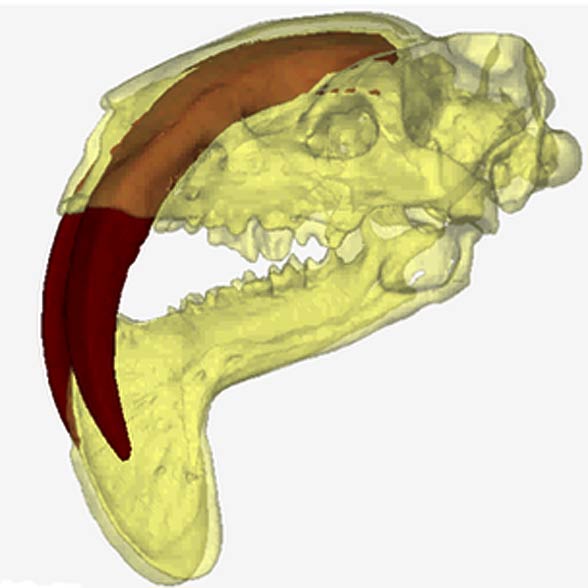
Thylacosmilus – curiosities
- Thylacosmilus was one of the biggest carnivorous marsupials. Its size was close to the Australian marsupial lion.
- Despite it was large, Thylacosmilus had very weak jaws. It is estimated it could generate a bite equal to the strength of jaws of present-day domestic cats.
- The similarity with smilodons is not the sign of a close relationship, but the phenomenon of convergence. It is the process of the formation of similar features of bodies with distant relationships.
